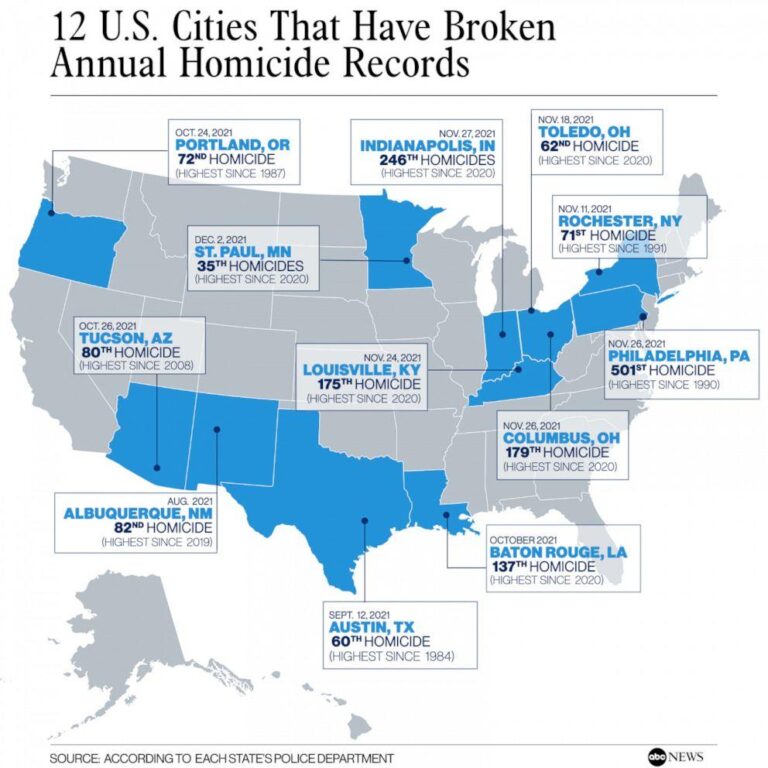In recent years, violent crime has remained a pressing concern across many urban areas in the United States. Understanding which cities experience the highest rates of homicide is crucial for policymakers, law enforcement, and communities striving to enhance public safety. This article delves into the latest data from USAFacts to identify the cities with the most alarming murder rates, exploring underlying factors and the impact on residents. By examining these trends, we aim to shed light on the complex dynamics driving these statistics and the efforts underway to address them.
Cities with the Highest Murder Rates Revealed by USAFacts Data
Recent data from USAFacts unveils a sobering reality about urban safety in America. Certain cities stand out due to their alarming murder rates, underscoring ongoing challenges related to crime prevention and community welfare. Leading this distressing list are cities where social and economic factors seem to converge, exacerbating violence and impacting the quality of life for residents. The data reflects a multifaceted issue—one intertwined with poverty, inequality, and strained law enforcement resources.
Among the worst hit urban centers, the following cities show the highest murder rates per 100,000 people:
- St. Louis, MO: Continues to struggle with a disproportionately high number of homicides.
- Baltimore, MD: Faces persistent violence issues despite recent community efforts.
- Detroit, MI: Experience notable spikes in violent crime in recent years.
- Memphis, TN: Records some of the highest per capita rates nationwide.
| City | Murder Rate (per 100,000) | Population |
|---|---|---|
| St. Louis, MO | 64.9 | 300,576 |
| Baltimore, MD | 44.3 | 586,131 |
| Detroit, MI | 37.0 | 639,111 |
| Memphis, TN | 38.5 | 633,104 |
Analyzing Contributing Factors Behind Elevated Homicide Rates
Urban environments with elevated murder rates often share a complex web of underlying contributors. Economic disparity remains one of the most persistent drivers, where limited access to quality education and employment opportunities fuels cycles of violence. Additionally, areas with high poverty rates typically experience increased social tensions and reduced law enforcement resources, which together create fertile ground for criminal activity. Community disinvestment further compounds these challenges by eroding neighborhood cohesion and diminishing informal social controls that traditionally deter violence.
Another critical aspect is the prevalence of illegal firearm circulation, which directly escalates the lethality of confrontations and crimes. Social factors such as gang activity and drug trafficking amplify violent disputes, often resulting in homicides. Local governance and policing strategies also play crucial roles; jurisdictions prioritizing community policing and intervention programs often witness reductions in murder rates. Below is a simplified breakdown of factors frequently linked to heightened homicide levels:
- High poverty and unemployment rates
- Limited educational attainment
- Significant gang presence
- Wide availability of illegal firearms
- Low community engagement
- Insufficient law enforcement resources
| Factor | Impact on Homicide Rate |
|---|---|
| Economic Instability | High correlation with increased violence |
| Gang Activity | Major driver of homicides in urban centers |
| Illegal Firearm Access | Amplifies lethality of disputes |
| Community Disinvestment | Weakens neighborhood social controls |
Community and Policy Responses to Combat Violent Crime
Communities across cities with elevated murder rates are mobilizing to address violence through grassroots initiatives and increased collaboration with local authorities. Neighborhood watch programs, youth engagement activities, and educational outreach are vital pillars of this response, fostering trust and resilience within affected populations. These efforts not only provide immediate support but also work toward mitigating the root causes of violent crime, such as poverty, lack of opportunity, and social disintegration.
On the policy front, city governments are implementing a range of strategies to reduce violent crime, including expanding community policing, investing in technology-driven crime prevention, and reforming criminal justice practices to emphasize rehabilitation. Funding priorities have shifted toward supportive services like mental health resources and job training, acknowledging that addressing systemic issues is crucial to sustainable safety improvements. Below is a brief overview of notable policy measures adopted by cities with some of the highest murder rates:
| City | Policy Initiative | Focus Area |
|---|---|---|
| Detroit | Violence Interrupters Program | Conflict Mediation |
| Baltimore | Expanded Community Policing | Neighborhood Safety |
| St. Louis | Job Training & Support Services | Economic Empowerment |
| Memphis | Data-Driven Policing Initiatives | Crime Prevention Technology |
Strategies for Improving Public Safety in High-Risk Urban Areas
Addressing public safety in high-risk urban zones requires a multifaceted approach that involves cooperation between law enforcement, community organizations, and local governments. Implementing community policing strategies has proven effective in building trust and fostering communication, thereby reducing violent incidents. Equipping officers with de-escalation training and investing in technology like real-time crime mapping not only enhance operational efficiency but also provide critical data for preemptive interventions. Additionally, improving street lighting and monitoring high-crime hotspots with surveillance cameras deter criminal activity without infringing on residents’ privacy.
Beyond policing, enhancing social infrastructure plays a crucial role in long-term violence reduction. Programs focused on youth engagement, job training, and mental health support target root causes of crime, offering alternatives to at-risk populations. Local governments often collaborate with nonprofits to launch targeted initiatives such as after-school educational activities, substance abuse counseling, and conflict resolution workshops that directly address community needs.
- Community Policing: Building local trust and transparency
- Data-Driven Approaches: Utilizing crime analytics for resource allocation
- Environmental Design: Enhancing urban spaces to discourage violence
- Social Programs: Focusing on prevention via education and support
| Strategy | Key Benefit | Example Application |
|---|---|---|
| Community Policing | Increased trust and cooperation | Neighborhood patrols and local forums |
| Crime Mapping | Targeted crime prevention | Real-time hotspots identification |
| Youth Engagement | Lower recidivism rates | After-school mentorship programs |
| Urban Lighting | Deters nighttime crime | LED streetlight installation |
In Conclusion
In conclusion, the data presented by USAFacts offers a stark reminder of the challenges faced by certain American cities grappling with high murder rates. While these statistics shed light on the severity of violent crime in specific urban areas, they also underscore the importance of targeted policy interventions, community engagement, and ongoing efforts to improve public safety. Understanding these trends is crucial for lawmakers, law enforcement, and residents alike as they work collaboratively toward building safer environments across the nation.




